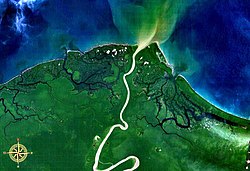| Mamberamo | |
|---|---|
 Mamberamo River, aerial view in 2017. | |
 Mamberamo, entering the sea, seen from space. | |
| Location | |
| Country | Indonesia |
| Region | Papua |
| Physical characteristics | |
| Source | confluence of Tariku and Taritatu |
| • coordinates | 2°55′30″S 138°26′30″E / 2.92500°S 138.44167°E |
| Mouth | Pacific Ocean |
• location | Teba, Indonesia |
• coordinates | 1°28′S 137°54′E / 1.467°S 137.900°E |
• elevation | 0 m (0 ft) |
| Length | 283 km (176 mi) (Mamberamo–Taritatu–Waruta 1,112 km (691 mi))[1] |
| Basin size | 78,992 km2 (30,499 sq mi)[1] |
| Depth | |
| • minimum | 3 m (9.8 ft)[2] |
| • average | 8–14 m (26–46 ft)[2] |
| • maximum | 33 m (108 ft)[2] |
| Discharge | |
| • location | Mamberamo Delta |
| • average | 5,500 m3/s (190,000 cu ft/s)[1] |
| Basin features | |
| Progression | Pacific Ocean |
| River system | Mamberamo River |
| Tributaries | |
| • left | Tariku |
| • right | Taritatu |
The Mamberamo (Indonesian: Sungai Mamberamo) is the second-longest river on the island of New Guinea, after Sepik River (1,126 km) and the second largest in Oceania by discharge volume after Fly. It is located in the Indonesian province of Papua. It is the second largest river in Indonesia by volume of discharge after Kapuas and also the widest.[3]
The river is formed from the confluence of its upper tributaries, the Tariku and Taritatu Rivers in the Lakes Plains region, an interior basin with extensive freshwater swamp forests and grasslands. It flows northwards between the Van Rees Range (Pegunungan Van Rees) and Foja Mountains through a series of rapids and gorges. The last 160 km of the river are navigable.[4] In the coastal lowlands, the river is lined with marshes and forms a broad river delta. The Mamberamo discharges into the Pacific Ocean at the northern point of Point D'Urville or Cape Narwaku (Tanjung Narwaku).
The river's huge valley is home to various uncontacted peoples and incredible biodiversity. In the 1990s, the Indonesian Government had plans to construct a large hydroelectric dam on the Mamberamo that would have submerged much of the area. This plan was shelved after the Indonesian financial crisis from 1998 to 1999, but there are concerns by environmental groups that it could be resurrected sometime in the future. At present, the Mamberamo remains the second largest river in the world to be completely unfragmented by dams in its catchment, behind only the relatively nearby Fly.[3]
The Mamberamo area also broadly refers to several nearby mountain ranges, including the Van Rees and Foja Mountains (also known as Foya), which were the subject of a recent rapid biological assessment conducted by Conservation International, the Indonesian Institute of Sciences, and Cenderawasih University. The scientific team discovered the first new bird species from New Guinea in 60 years, and a wealth of other new plants and animals. The Foya Mountains appear to be a globally outstanding repository of biodiversity.
- ^ a b c Joesron, Loebis (2008). Country Report Implementation of Demonstration Project Mamberamo River Basin Indonesia (PDF) (Report). Indonesian Hydrological Society.
- ^ a b c Agus, Sugiyono (2023). PENGEMBANGAN PLTA MAMBERAMO TERINTEGRASS.
- ^ a b "Fragmentation and Flow Regulation of the World's Large River Systems" (PDF). Archived from the original (PDF) on 2012-03-30. Retrieved 2013-01-12.
- ^ "Mamberamo River". Encyclopaedia Britannica. Accessed 7 June 2020